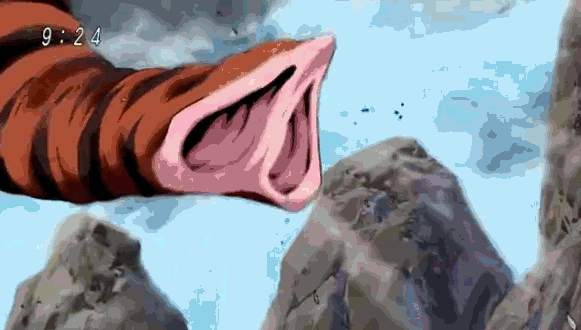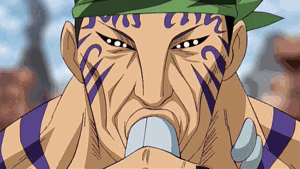I can figure out some of you already thinking, "Wait, so there are some manga and anime that focus on food?" Pretty much, yes.
Really, there is a surprising amount of food-based anime that have come and gone. Right now, there is 'Shokugeki no Soma', a manga series dealing with the protagonist training in one of the most illustrious (and incredible tough) culinary schools. The author of the manga collaborated with an actual chef to come up with a lot of the recipes that are used in the story. Also tends to use a lot of metaphors of describing the food, along with imagery that makes them look downright amazing.
There was also the 'Fightin Foodon' series, which had different food and dishes transforming into creatures that fought one another. It certainly fits the more ridiculous side of anime, with a lot more comedy thrown in. It has so much that some would've considered it a rip-off of the 'Pokemon' anime, but it embraces its over-the-top nature to a higher degree than 'Pokemon'.
As for the series today, it certainly places emphasis on food, how to capture it and prepare it for eating. The thing is, getting the ingredients can be a daunting task, one suited only for hunters specialized for such a task.
One such 'Gourmet Hunter' is the titular character, Toriko!
(This ain't your typical Shonen anime)
Debuting in 2008, 'Toriko' is a Shonen manga focusing on a cast of characters hunting down the rarest of ingredients, often going to dangerous locales to capture, prepare and eat. Seems simple enough, except for the hundreds of dangers in their world, like powerful monsters capable of destroying cities and organizations bent on capturing the best ingredients for themselves.
The image itself speaks for itself, standing out from the usual shonen stories by subverting old tropes. For example, the titular hero Toriko isn't a kid nor teenager. He's that big blue-haired, muscle bound man in the orange jumpsuit. He is also a Gourmet Hunter, one whose been trained to fight off some of the most monstrous creatures in the world and eat to his heart's content. His body, alongside other Gourmet Hunters, possess 'Gourmet Cells', granting them incredible physiques that can perform amazing techniques. For Toriko, he utilizes a fighting style with his hands as a 'fork' and 'knife' (a clawed and chopping hand respectively), as well as the 'Nail Punch', which allows him to strike an area or person with repeated and focused force.
As with most Shonen stories, Toriko isn't alone in his adventures. He is later joined by his old friend Coco (the guy in black and green) who uses poisons in order to defeat monsters. I'm not talking about setting traps with poisons either: his body is composed of so much poison that he is capable of launching it outwards like bullets and even form into hardened objects like arrows and armor. There is also Sunny, whose flamboyant hair is so long and so strong that it is capable of lifting objects several hundred times his own size. Like Toriko, they are also Gourmet Hunters.
But what is a Gourmet Hunter without a Gourmet Chef?
Enter Komatsu, a chef from a five star restaurant under the IGO Corporation, which helps in maintaining the food supply and research into new flavors and ingredients. While he may not possess the combat skills that would benefit Gourmet Hunters, he does have the fine cooking skill to prepare the captured ingredients for consumption. Also think of him as the eyes of the readers, seeing just how strange this world truly is through the eyes of someone living in it.
The image itself speaks for itself, standing out from the usual shonen stories by subverting old tropes. For example, the titular hero Toriko isn't a kid nor teenager. He's that big blue-haired, muscle bound man in the orange jumpsuit. He is also a Gourmet Hunter, one whose been trained to fight off some of the most monstrous creatures in the world and eat to his heart's content. His body, alongside other Gourmet Hunters, possess 'Gourmet Cells', granting them incredible physiques that can perform amazing techniques. For Toriko, he utilizes a fighting style with his hands as a 'fork' and 'knife' (a clawed and chopping hand respectively), as well as the 'Nail Punch', which allows him to strike an area or person with repeated and focused force.
As with most Shonen stories, Toriko isn't alone in his adventures. He is later joined by his old friend Coco (the guy in black and green) who uses poisons in order to defeat monsters. I'm not talking about setting traps with poisons either: his body is composed of so much poison that he is capable of launching it outwards like bullets and even form into hardened objects like arrows and armor. There is also Sunny, whose flamboyant hair is so long and so strong that it is capable of lifting objects several hundred times his own size. Like Toriko, they are also Gourmet Hunters.
But what is a Gourmet Hunter without a Gourmet Chef?
Enter Komatsu, a chef from a five star restaurant under the IGO Corporation, which helps in maintaining the food supply and research into new flavors and ingredients. While he may not possess the combat skills that would benefit Gourmet Hunters, he does have the fine cooking skill to prepare the captured ingredients for consumption. Also think of him as the eyes of the readers, seeing just how strange this world truly is through the eyes of someone living in it.
(Like this green haired guy attacking the pressure points of this one handed clown)
(How about the massive 'Regal Mammoth', who is miles across big that eats smaller animals through its two nostrils)
(Then there's the time Toriko fought a guy with four arms that uses a GIANT STRAW as a weapon.)
Can't tell if I've already said it before, but anime and manga are so weird.
Anyway, there is a big prize at the end of this adventure. Long story short, the world was involved in an intense war that destroyed millions of lives thanks to food shortages. Thanks to the discover and consumption of legendary ingredients (the chief among them being named GOD), the leaders of the world came to a true and the 'Gourmet Age' was born. Now, Toriko is among the many who go out to see these legendary ingredients, as well as the IGO and villainous groups like the Bishokuyou.
So, are all these ingredients really as great as they sound? Well...
...there is the Rainbow Fruit, a long-thought extinct fruit whose juices are capable of turning an olympic-sized pool into said juice, whose flavor can change seven times in a person's mouth while eating it...
...there is the Jewel Meat, a piece of the dangerous Regal Mammoth, that combines all the tastes of other meats into one, which glistens the air through its bright radiance...
...there is the Century Soup, a rare delicacy that can only be made every one hundred years in the inhospitable 'Ice Hell' continent, whose taste and aura is capable of satisfying those that manage to acquire it (while leaving a dopey smile across their faces)...
...okay, I'm getting hungry just thinking about it. Thankfully, that is why we have Thanksgiving leftovers.
Until next time...
So, are all these ingredients really as great as they sound? Well...
...there is the Rainbow Fruit, a long-thought extinct fruit whose juices are capable of turning an olympic-sized pool into said juice, whose flavor can change seven times in a person's mouth while eating it...
...there is the Jewel Meat, a piece of the dangerous Regal Mammoth, that combines all the tastes of other meats into one, which glistens the air through its bright radiance...
...there is the Century Soup, a rare delicacy that can only be made every one hundred years in the inhospitable 'Ice Hell' continent, whose taste and aura is capable of satisfying those that manage to acquire it (while leaving a dopey smile across their faces)...
...okay, I'm getting hungry just thinking about it. Thankfully, that is why we have Thanksgiving leftovers.
Until next time...









